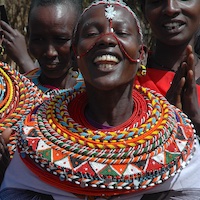kenya

Kenya
Travel Guide
Kenya lays claim to the creation of the safari experience. The Great Rift Valley, the mountain highlands and the Indian Ocean coastline with their white sandy beaches are just a few of the many highlights. Kenya is home to the Big Five , and you'll have close encounters with elephants, rhinos, lions, and other wildlife.
Find your joy
Not sure where you want to go yet? Get inspired and browse the best places to visit in Kenya
Browse some of our Kenya itineraries
Get excited and browse our selection of our favorite hand made tours from Kenya. From romantic honeymoons to family-fun; these are completely flexible and arranged to your needs.
Why visit Kenya?
Kenya is safe and offers a wide range of wildlife and breathtaking landscapes, as well as a warm melting pot culture
Masai Mara
The Masai Mara National Reserve in Kenya is undoubtedly Kenya's safari hotspot. It is best known for the annual Great Migration, which sees millions of herbivores move from Tanzania's Serengeti National Park between June and October.
Big Cats - Leopards, Cheetahs, and Lions
Many safari travelers to Kenya hope to witness the Great Migration, Africa's "Amazing Race". You don't need to go on safari in particular months to enjoy amazing animal action. The Big Cats of Kenya can be seen all year round.
Rift Valley Lakes Teeming with Flamingos
Africa's Rift Valley lakes network spans three large catchments and several borders. Eight of these lakes are found in Kenya, including Lake Naivasha which is a freshwater resource that attracts a wide variety of birdlife. Lake Nakuru a "soda" lake, is famous for its large flocks and abundance of flamingos that frequent the shallows.
Maasai People
The Maasai is one of the most well-known African cultures. Many derivatives of this heritage exist, each with its own traditions and customs. This can be seen in the Maasai Mara Reserve's cultural villages, which blend into a harmonious relationship with the wildlife deep within the African bush.
A Wildlife Paradise
Kenya, the country that is home to wide-open Savannah plains and safaris, is also known for its wildlife. The most well-known are the Maasai Mara Amboseli, Tsavo and Samburu. There are more than 60 national parks and reserves throughout the country.
The Great Migration
Africa offers many amazing wildlife experiences, but the Great Migration is perhaps the most breathtaking. It is an unforgettable experience and a must-see for everyone. One million wildebeest traversing the plains of Africa. Serengeti While searching for fresh grass, you must brave predators and treacherous river crossings.
The Great Migration & When to Visit
The Great Migration refers to the annual 600 mile (1,000 km) clockwise movement of approximately 1.5 million wildebeest, 250,000 zebras, and 400,000 Thomson gazelles through the Serengeti-Mara ecosystem as part of their search for water and green pastures. The movement of the migration is determined by the seasonal rain patterns which may vary from year to year, but the path of the migration remains essentially the same.
December – April
Southern and Eastern Serengeti
Usually some time in November the rains begin in Tanzania and the parched landscape of the southern and
eastern plains of the Serengeti-Mara ecosystem spring to life.
The availability of water and the nutrient-rich short grass plains coaxes the animals to depart the North Serengeti
and begin their annual southbound trek.
The massive herds typically occupy the southern and eastern plains from December to April.
A note on February: The wildebeest have evolved to synchronize their calving, with majority of the female wildebeests giving birth within a three week period in February as a survival strategy. The birth of up to 500,000 calves during this period makes it impossible for the predators to hunt and kill them all, giving the majority of the wildebeest calves good chance at avoiding predation. Due to the wildebeest calving, February is peak season on the southern plains. If you plan on traveling during February, book your accommodations 6 – 8 months in advance to ensure availability.
May – June
Central and Western Serengeti
At some point in May, the rains cease and the dry season sets in. The short grass plains quickly dry up and with no permanent water source, the Great Migration is forced to slowly begin their north-westerly trek following the Seronera and Mbalageti Rivers through the Central Serengeti from May to June.
May is the mating season of the wildebeest. Expect to see fierce competition between the males as they battle to win the right to mate as they trek through the Central Serengeti.
By mid-June, the Great Migration will be in the Western Serengeti, also known as the Western Corridor. The highlight here is the Grumeti River, home to some of the largest Nile crocodiles in the world. At this point, they have not eaten since the previous year, and patiently waiting for the Great Migration to bring them their next meal.
July to November
Northern Serengeti
By July, the massive herds are heading to the North Serengeti. The famed Mara River crossing will begin in July and throughout August to October the Great Migration will remain the North Serengeti. The Mara River is the most serious obstacle for the Great Migration in its 600 mile (1,000 km) trek.
Tens of thousands of stampeding wildebeests and zebras will frantically cross the turbulent muddy waters teeming with enormous Nile crocodiles. Thousands will perish in the panic and confusion. It is a dramatic sight to behold. The herds will cross back and forth across the Mara River several times depending upon periodic rain showers.
By November, the rains have started in the southern Serengeti and the herds will quickly move vast distances in a day to reach their southern pastures where the whole cycle starts over again.
It's more than just having a good time or visiting beautiful places (although that's absolutely a part of it!), it's about being part of a unique experience that stays with you.



